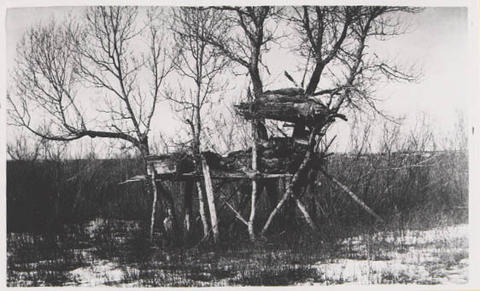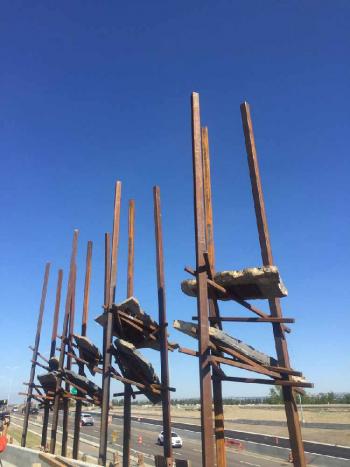Image Caption
By Shari Narine
Windspeaker Contributor
TSUUT’INA NATION, Alta.

Blood burial scaffold. (http://sain.scaa.sk.ca/items/index.php/blackfoot-blood-burial-scaffold)
The Bowfort Towers project needs to be “rebirthed,” said Tsuut’ina Nation spokesman Kevin Littlelight.
It’s an interesting word choice considering Indigenous people can’t help but see burial scaffolds when they view the recently revealed work by New York artist Del Geist near the Trans-Canada Highway at Bowfort Road in Calgary.
“I would like (the City of Calgary) to take it down, and if they have commitments to the artist, maybe get the artist to really work with Blackfoot artists and do a rebirth and really get some Indigenous artists from this area…to make major changes on it,” said Littlelight.
“This is a total opportunity for (Geist) and the city to really find out and immerse themselves in our culture.”
The Bowfort Towers project not only appears to highlight a custom that was lost to First Nations people when they were put on reserves and forced by missionaries not to lift their deceased to the Creator any longer, but to bury them in the ground, but it also outlines how much work needs to be done for reconciliation.
For Littlelight, it is vastly disappointing.
Late last year, Littlelight was one of many vocal Indigenous people to lead the charge for the renaming of Langevin Bridge in Calgary. Sir Hector-Louis Langevin – one of the Fathers of Confederation and the bridge’s namesake – was a proponent of the government’s residential school system. This past January, Calgary City Council voted to rename the bridge Reconciliation Bridge as “a sincere act of reconciliation on behalf of the citizens of Calgary.”
Renaming the bridge was noted in “The White Flying Goose Report,” produced by the Calgary Aboriginal Urban Affairs Committee under the direction of city council. The report examined the steps Calgary could take to implement the municipal calls to action outlined by the Indian Residential Schools Truth and Reconciliation Commission.
The report states, “For The City of Calgary to consider re-naming the bridge to a name that signifies building communities rather than dismantling them is a powerful symbol of mutual respect for the future.”
The report also called for the TRC’s recommendations to be implemented in all aspects of life, including corporations, community and school. It also noted that resources needed to be set aside to educate city employees and departments.
Now, says Littlelight, the Bowfort Towers project signifies “a huge step backward” for the city.
“This was a lack of communication and that the TRC itself is not reaching the right people,” he said. “The law is not going to come and tell you what the law is. (The Public Art Board) has to go and figure it out; so laziness on their part. For them not to know is pure ignorance.”
There were no Indigenous people on the Public Art Board that made the calls for the project or who made the decision on the successful proposal. A major oversight, he notes, considering the placement of the artwork at the base of Paskapoo Slopes, which is an important Indigenous site.
Littlelight also points out that the Public Art Board didn’t contact the Treaty 7 Nations to let them know about the art call.
Of the work itself, Littlelight says he has not spoken to Geist – although he would like to – and so doesn’t know if Geist intended for his work to reflect burial scaffolds. But Littlelight says had Geist “Googled” Blackfoot people he would have found the reference.
It is “very, very, very disappointing” to go from what was accomplished in January to what transpired last week, admits Littelight, saying he asked Tsuut’ina youth whether he should care about what happened.
“They said I should absolutely care. We have to fight this,” he said.
Littlelight is waiting to hear from city officials, including Mayor Naheed Nenshi, whose “radar (he is) certainly on” and adds that nobody from Tsuut’ina Nation has been approached by Calgary.
“The city really needs to be more careful about how it’s going to represent itself…. Nobody comes to Calgary to look at New York art. They come here to look for Aboriginal art, they come here to look for western culture and the only people who can translate that art is western artists, from Alberta, Native and non-Native,” said Littlelight.
Update: Calgary Mayor Naheed Nenshi put our a release on Aug. 10 about the towers: http://calgarymayor.ca/stories/mayor-nenshi-on-bowfort-towers
He quipped: "When I heard about the Bowfort Towers last week, I have to admit that my first thought was 'just once, can't it be a statue of a historical figure on a horse', but I don't get to decide that.
He went on to say however
"I understand that City Administration followed all the applicable policies. The artist was chosen from an open competition by a panel of seven people, which includes six citizen volunteers. In accordance with the City's Indigenous Policy Framework, engagement with the Indigenous community was undertaken with a Blackfoot traditional knowledge keeper who is an expert in archeology and culture. Our Indigenous protocols are not about politician to politician consultation, rather they are about engagement with the traditional knowledge keepers as recommended by the Calgary Aboriginal Urban Affairs Committee.
"But I want to figure out how we wound up with art that many people don't like. The changes we made in 2014 to our Public Art Policy were designed to get more public input, but clearly it hasn't worked and we need to do better."

